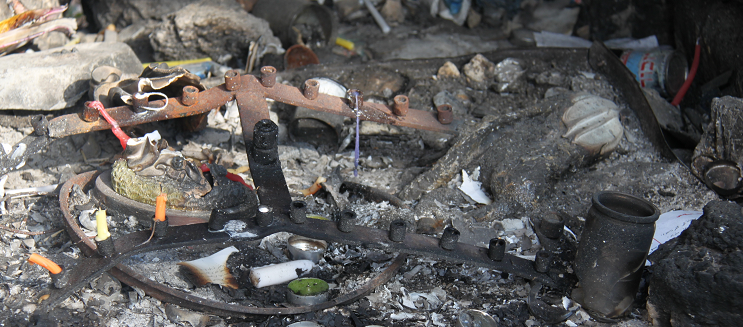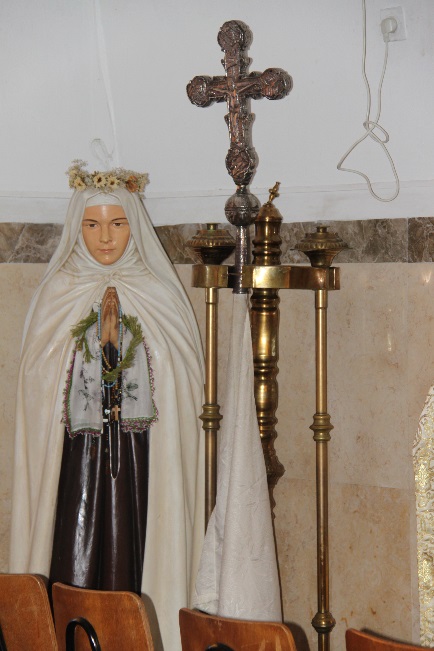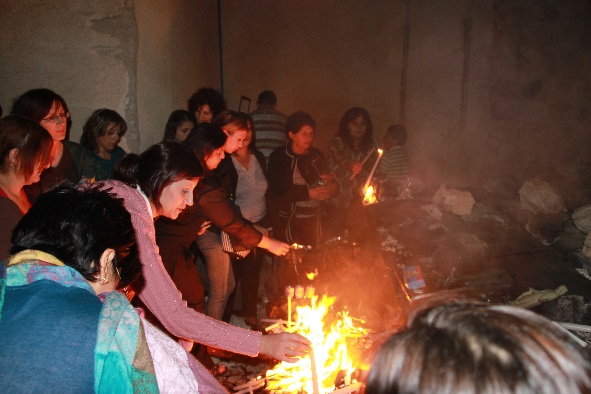







The Shrine of Mariam Baouardy at Iblin
The shrine of Mariam Baourady is locatrd in Iblin. Mariam Baouardy was born on January 5, 1846 in the village of I'billin. She was professed a Carmelite nun on November 21, 1871. According to the textual tradition, she endured harsh supernatural adversities, diabolic possessions, and stigmata. On the other hand, she was endowed with the ability to read people’s hearts, the gift of prophecy, and facial radiance. Baouardy died in Bethlehem on August 26, 1878 and was buried in her hometown: the Galilean village of Ibillin. Some 95 years later, Pope John Paul II sanctified Baouardy in a solemn ceremony at the Vatican City, whereupon her shrine in Ibillin has become a magnet for pilgrims who partake in a vibrant form of cult worship.
Nurit Stadler
The Celebration of Mariam Baouardy at Ibbelin
October 29, 2011.
Nimrod Luz and Nurit Stadler
On a Saturday, the last day of October 2011 we travelled to the village of Ibbelin. We started by climbing on the hill, and left the car very close to the house of As’ad Daud. As’ad had his house open as part of the olive oil festival in the Galilee. As’ad's family has been producing olive oil for centuries and they have an olive oil press at home for hundreds of years. In the inside garden the family placed a table with lots of olive oil bottles as well as olive oil soap. We were sad to learn that very few people visited the house and As’ad and his brother

complained that publicity was minor and not effective. They looked very disappointed. The two brothers took us to the olive oil press and demonstrated how the factory worked for years, and all about the reconstruction work they are doing to keep it alive. Soon enough, we deepen into a long conversation about the politics of the village, the interreligious relations, especially the relations between Christian (Catholic and Orthodox) and Muslim at the divided village. When we asked about the celebrations of Mariam Baouardy, they told us that tragically, two women from prestigious Christian families died this week and that their death have jeopardized the celebrations. We decided to walk towards the Catholic Church of the Ibbelin and see how things look from their perspective, and perhaps talk with the organizers of the event to see if it will take place.
Two churches adorn the old center of the village of Ibbelin. The Orthodox Church, that was recently renovated, and the Catholic Church. A new church of the Greek-Catholics (Melkite) was built in recent years as part of the education complex known as the Mar Elias College. Few days before our visit, we received a very kind and formal invitation from Father Michel the local priest, and Mr. Zuheir Huri, a prominent figure in the Catholic community of Ibbelin and one of the head organizers of the celebration and according to his description, a pious Catholic. When we did arrive to the Catholic Church it was already empty. We noticed that the Icon or Mariam Baouardy was placed outside the church. We saw the icon a few moth ago in our previous visit. According to father Michel the icon was a gift to the people of Ibbelin from the Vatican and it was designed in her image, and according to her real size. The Icon was placed at the entrance hall close to the three picture of Mariam Baouardy, and was decorated with many flowers. When we headed outside a group of cheerful catholic youth movements, dresses all with a Khaki uniform, came near us and explained that everybody went to the other hill and that the procession will take off around 4:00 PM, from the Mar Elias complex[1]. They pointed to the hill and enter a big car. It was just before they disappeared that Nimrod asked how much time it would take us to walk there, they shouted "about ten minute". We asked when it will all start and one of them shouted again that the praying will start at 4:00, the time was already 4:10pm, we corrected them and they said ok so it is probably at 5:00pm. Therefore, we decided to walk. In order to cross to the other hill we had to go down the slope, right to the heart of the village and then climb to the top of the hill. The village revealed itself. Small houses, surrounded by fruit trees, flowers, dogs, and chickens walking free. In first sight, the Mar Elias complex looked close, however, after walking ten minutes, or more, we realized it will probably take a lot more. The pave road ended and turned into a dirt pathway. After a difficult climb up the hill we found ourselves in the middle of an olive tree orchard, right behind it was the complex and the church, it was almost 5:00pm and we rushed ahead toward the complex. However, in this moment we also realized that the orchard was fenced, from all sides, and the only path out was fairly high. We recognized that we have reached the complex from the wrong side. This is probably the reason why we did not see anyone walking with us. From one of the windows we heard a voice, it was one of the priests, and he shouted loudly that we have to turn back, because there is no way to enter the church through the orchard. We gathered that if we turn to the other path we will be late and that we will miss the event. We also felt ashamed because we promised our hosts to be there at 4:00 pm. We heard another voice screaming towards us "go back, there is no way from here". The barbed wire was all around us, threatening our cloth and skin. Nimrod decided to jump, he passed the wire and jumped from the fence, Nurit was less brave, but finally she realize it is getting very late, she jumped over with her feet standing on Nimrod's shoulders until landing safely on the other side. Once this unexpected adventure ended (the wonderful plights of doing ethnographyJ, we started walking towards the church. Walking fast, now on our feet, we reached the stairs and enter the church that was now full of people, mostly women. A priest that was standing at the entrance, smiled kindly and said to us: "finally you have arrived". He told us that he saw us at the orchard, and he was pleased that we made it to the church.
made it to the church.
Inside, the church was crowded. We noticed Zuheir, our host standing in the first line; he recognized us and pointed us to en empty sit. However, the real action was outside the church. We could hear the noise of the children outside the church, all from the various Christian youth movements, shouting, laughing, singing, marching and playing their instruments, preparing to the procession that will take off soon. Zuheir approached us and started talking about the church. Catholics and Orthodox together prayed in devotion. He explained that they all share their devotion to Mariam Baouardy. It was obvious that most of the people in the church came from the same village. People knew each other, blessed each other and immersed in deep conversations. Women came with their children, and babies dressed elegantly. Men were less prominent among the audience. 
Zuheir explained in details about the complex, the architecture of the church, and the iconography, especially the byzantine iconographic painting style of the virgin. Archbishop Shakur gave a long homily in both Arabic and English. Later, after the prayers ended, all devotees in the church stood in a long line for the Eucharist ritual. After an hour and a half long mass, we went outside the church and asked Zuheir about the procession, and he said that it started in 1983[2]. The yard outside the church was now full of people. Children with white bandanas on their forehead decorated with the icon of Mariam Baouardy, holding flags of youth movements, the village of Ibbelin and to our surprise Israeli flags. In recent years this is not a common feature in processions and demonstrations of minority communities in Israel and certainly not among Muslim communities. A small-improvised market sold candles, pictures, and many other things attracted only few people. At the center, we noticed a small pick-up truck; in the back of the car a big photo of Mariam Baouardy was displayed. Parents placed their little children beside the photo and took pictures. These preparations lasted for another 30 minutes, and then we all started moving after the van, more than 1000 people walked slowly together and there were more who joined us from every corner, especially teenagers, dressed elegantly, talking to each other, playing with their I-Phones, taking pictures, talking loudly on the phone. The procession lost many people to food stores and candy stores, and we started the difficult part- climbing up the hill towards the shrine of Mariam Baouardy. All participant seemed happy, and enjoyed the procession very much. It was obvious that this was the sacred time of the Christians of the village that is sharply divided; Muslims did not participated and only a few of them watched the celebrations. When we arrived at the shrine of Mariam, it was already full of candles. Women with children prayed and lit candles at the shrine.  They sang, prayed, and took picture of the children. Women asked for good health and fertility. At this moment the procession split. Some people stayed at the shrine, as their last destination and some went towards the Catholic Church for candies, special merengue cookies, and pray. We were treated to a private audience with father Michel and Zouheir in father Michel’s private residence and soon after a small talk we parted ways.
They sang, prayed, and took picture of the children. Women asked for good health and fertility. At this moment the procession split. Some people stayed at the shrine, as their last destination and some went towards the Catholic Church for candies, special merengue cookies, and pray. We were treated to a private audience with father Michel and Zouheir in father Michel’s private residence and soon after a small talk we parted ways.
[1]In 1965 father Elias Shakur, originally from Kufr Bir'im, later Archbishop of Galilee, established a school open to all local children, regardless of religious affiliation. Elias Shakur was the Archbishop of Acre, Haifa Nazareth and all the Galilee the Melkite Greek Catholic Church from 2006 to 2014. Noted for his efforts to promote reconciliation between Arabs and Jews, he is the author of two books about the experience of Palestinian people living in present-day Israel. He describes himself as a "Palestinian-Arab-Christian-Israeli. He established the Mar Elias Educational Institutions, an educational complex consisting of a kindergarten, elementary school, junior high school, high school, college and university. The educational complex is located on Jabal al-Ghoul (Hill of Demons), on property belonging to the Melkite Church. The hill has been renamed Jabal al-Nour.
[2] This is the year Mariam was beatified by Pope John Paul John II